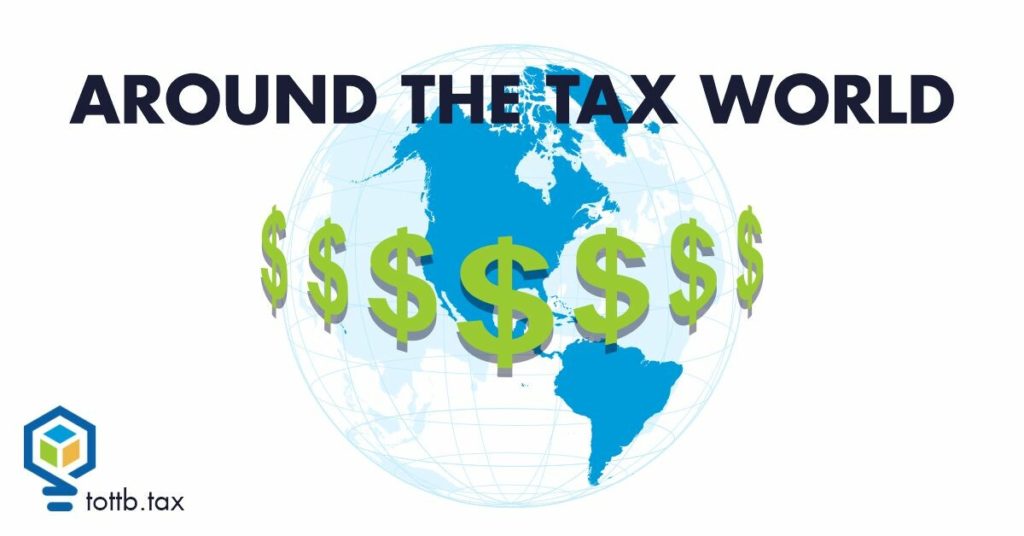
At Around the Tax World, you can find out all about what’s going on in the wonderful, worldwide world of tax. Every month, we’ll feature a few mini-articles on what’s been going on in the world when it comes to tax, and fully available for viewing even if you don’t have a subscription.
If you wish to subscribe and gain access to all articles on the site, be sure to check out the benefits of doing so here!
Check out what’s happening all around the world of tax!
WORLD NEWS
Oakland-area small business owners rally in support of the suspended police chief… after accusations of favoritism in doling out discipline to officers. Chief LeRonne Armstrong was praised by local entrepreneurs for his response to an increase in assaults, robberies, and thefts aimed at Asian Americans during the pandemic. LeRonne added to the number of police officers on foot and in vehicles, as well as offering his support to a citizen patrol group called the Blue Angels. A series of recent break-ins have exacerbated the community’s desire to resolve the question of who will head up Oakland’s police force.
The National Federation of Independent Business released its new numbers… for the monthly optimism index. In January, the index rose 0.5 to 90.3, up from 89.8 in December. These readings are still both below average for the past 49 years. Analysts found that small business owners have remained cynical about labor and inflation—26% of owners count inflation as the number one obstacle to managing their business, and 91% of owners looking to fill an open role reported dealing with unqualified applicants.
U.S. NEWS
Amazon’s average cut of small business sales surpasses 50%
Marketplace Pulse conducted a study of seller transactions dating back to 2016 to calculate the total cost of selling goods on Amazon. Almost 2 million small businesses sell their wares on Amazon.com. Researchers totaled the commission on each sale, fees for warehouse storage, packing and delivery, and advertising for better positioning on such a popular platform.
Last year, as Amazon saw its slowest sales growth in history, the company also took its largest cut of sales, rising to over 50% in 2022. For the past six years, sellers have seen increases in the amount paid to Amazon, but before the pandemic, this was offset by a steady stream of new customers and booming sales. After lockdown regulations were lifted, online shopping saw a decline, consumers became more thrifty as inflation rose, and therefore merchants became hesitant to raise prices.
Given the lower sales and increased fees, many sellers are now struggling to make a profit. Amazon also benefits from the number of small businesses that rely on its logistics services, which cost an average of 30% less than other shipping companies. The same is true for Amazon’s advertising services, which are optional but considered by many to be essential for drawing in customers.
Last year, Amazon’s profits were owed thanks to their cloud computing business, Amazon Web Services—without this income, Amazon would have posted a $10-billion operating loss. In an attempt to improve business, Amazon cut 18,000 corporate jobs, raised the price of Prime subscriptions, and plans to charge a fee for online grocery orders of less than $150.
Still, increasing costs to merchants—who may make 90% of their income through Amazon—is less risky than charging customers more. Costs of Amazon logistics are expected to go up by as much as 8% due to a new fee structure and other upcoming changes. While sellers cannot scale back on all costs, they can reduce their advertising spend, reflected in the lower numbers this year. Amazon has opted to set aside more space for advertising, which conversely also makes each spot less valuable.
As the cost of doing business rises, business owners will find it especially valuable to reduce their tax liability. For expert assistance in increasing your tax savings, reach out to a Certified Tax Planner.
STATE NEWS
Iowa small business owners join the Small Business Voices to petition Congress… and demand that legislators reauthorize the Small Business Administration (SBA). Fifty local businesses joined a coalition of 3,000 businesses nationwide seeking greater government support and updated tools and programs. Congress has not reauthorized the SBA fully since 2000, according to a record by the Bipartisan Policy Center.
A survey conducted by the Goldman Sachs 10,000 Small Businesses Voices found that 96% of small business owners believe that federal government programs do not yet sufficiently reflect and serve small businesses’ needs. Of the businesses surveyed, 68% were financially optimistic in 2023 and 60% expect profits to increase this year. At the same time, 72% of business owners have felt an increase in pressure due to inflation over the past three months. 61% report a negative impact from higher interest rates, and 35% cite finding and retaining qualified employees as their top business challenge. Iowa’s labor force has decreased by 35,000 people since spring of 2022.
The Connecticut Community Outreach Revitalization Program celebrated $1 million in funding for small business owners… to boost the local economy. Known as ConnCORP, the program provides grants to small, minority-owned businesses. The grant will be meted out over five years. The incubator focuses on uplifting those within the Newhallville neighborhood in New Haven, one of the most poverty stricken areas in Connecticut. By supporting entrepreneurship, the program hopes to create opportunities for low and moderate-income underserved populations.
The incubator currently engages with 9 Black-owned businesses, out of 11 businesses total. The program supports entrepreneurs as they turn their ideas into businesses and navigate basic logistics like paperwork. ConnCORP’s aim is to strengthen the businesses already in the community and avoid contributing to gentrification.
ConnCAT, a job training and educational program for youth, is also planning to erect the Dixwell development, which will include 184 housing units, a supermarket, restaurants, retail spaces, a Performing Arts Center, an office tower, townhouses, greenhouses, and a community plaza. ConnCAT anticipates that the property will bring $1 billion to New Haven, in addition to 600 jobs and 700 construction jobs.
TAX PLANNING
Intuit purchases $1 million in goods from local small businesses to be donated to nonprofits. The financial technology company took this step in honor of its first “Small Business Big Impact Day.” Intuit QuickBooks and Mailchimp are leading the charge in applying their parent company’s core value of “We Care & Give Back” which encourages employees to invest in improving their local communities.
Over 10,000 employees from 17 different Intuit sites participated in this initiative from offices across the Americas, Australia, Europe, and Asia. More than 200 small businesses benefited, and 40 nonprofits received donations of items like hygiene kits, pantry food bags, and blankets. Employees also contributed an estimated 10,000 volunteer hours to sort, package, and deliver these products. Intuit will also offer a virtual experience for remote workers to participate in Small Business Big Impact Day.
The U.S.-based small businesses and nonprofits involved are located in Atlanta, Georgia; Boise, Idaho; Fredericksburg, Virginia; Los Angeles, California; New York, New York; Plano, Texas; Reno, Nevada; San Diego, California; the San Francisco Bay area; and Tucson, Arizona.
59% of small businesses are struggling with income due to late payments, according to a survey by market research and data analytics firm YouGov. Additionally, almost one-third of small businesses say that receiving payments 20 to 30 days after their due date is putting them at risk for closure.
Experts recommend taking these four steps for dealing with late payments. First, optimize your cash flow by collecting a deposit before a job, invoicing in advance, drafting a contract that stipulates terms of payment, doing a credit check of the business or individual paying you, and digitally tracking your invoices. Second, be prompt with following up on late payments. Reach out to the customer via email, attach a copy of the invoice, and remind them of their options for payment method. Next, if a month has passed with no email response, call the customer. Identify the correct person to speak with about payment and focus on the agreement made.
Lastly, if the customer fails to take steps toward payment, you have three final courses of action. You can refuse to complete further work and restrict access to any shared documents or brand assets. You can also go to a collection agency that will follow up with the customer in exchange for 20% to 35% of the payment collected. If necessary, you can take legal action if the damage is substantial and worth the investment of time and money.
NOT A MEMBER YET?

SUBSCRIBE TO GET ALL OF OUR
GREAT ARTICLES AND RESOURCES!
CURRENT EDITION

Summertime Marketing in Your Tax & Accounting Firm
Tax season is prosperous, summer is dry until extension season. Do you find yourself in that cycle? Clients are “easy” to get during tax season when taxes are top of mind. Then the direct deposits go dry by June, and you are looking for what’s next. Stop the search, you don’t have to add another service. You need better marketing to highlight the service that you offer and specialize in. This will allow you to have a predictable client pipeline. You can do tax preparation, planning, and or representation all year long.

Observations on the House-Passed OBBB
This article focuses on the OBBB from the House offering a variety of observations to help understand the range of changes, relevance to compliance and planning, process considerations and some unexpected provisions. While the final OBBB will not include all of the House provisions or will modify some of them, there are lessons to learn to understand the tax legislation process and results now and in the future.

Client Retention as a Prospecting Strategy: Turning Current Clients into Referral Sources
In the competitive accounting world, where trust and reliability are paramount, client retention is not just a success metric—it’s a vital strategy for sustainable growth. For Certified Public Accountants (CPAs), accountants, and bookkeepers, maintaining a solid relationship with existing clients can unlock new business opportunities, turning satisfied clients into powerful referral sources.

